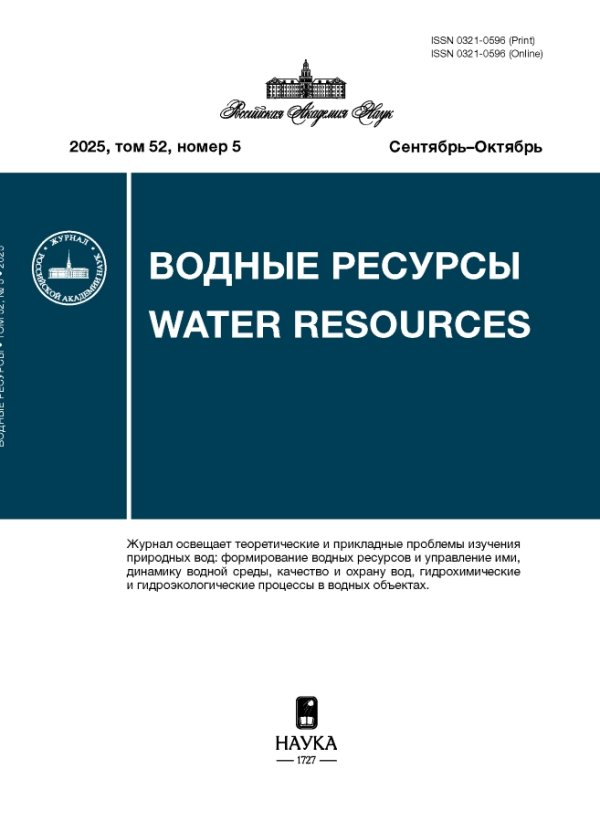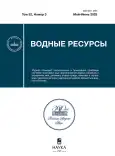Monitoring of organohalogen compounds in the Northern Dvina River using the parameter of mass concentration of adsorbed organically bound halogens
- Authors: Koroleva T.A1, Bykov V.M1, Moskalyuk E.A2, Korepina E.V2
-
Affiliations:
- N. Laverov Federal Center for Integrated Arctic Research, Ural Branch of the Russian Academy of Sciences
- JSC “Arkhangelsk Pulp and Paper Mill”
- Issue: Vol 52, No 3 (2025)
- Pages: 57-69
- Section: ГИДРОХИМИЯ, ГИДРОБИОЛОГИЯ, ЭКОЛОГИЧЕСКИЕ АСПЕКТЫ
- URL: https://bakhtiniada.ru/0321-0596/article/view/307876
- DOI: https://doi.org/10.31857/S0321059625030056
- EDN: https://elibrary.ru/SYQTLN
- ID: 307876
Cite item
Abstract
About the authors
T. A Koroleva
N. Laverov Federal Center for Integrated Arctic Research, Ural Branch of the Russian Academy of Sciences
Email: tataak@mail.ru
Arkhangelsk, Russia
V. M Bykov
N. Laverov Federal Center for Integrated Arctic Research, Ural Branch of the Russian Academy of SciencesArkhangelsk, Russia
E. A Moskalyuk
JSC “Arkhangelsk Pulp and Paper Mill”Novodvinsk, Russia
E. V Korepina
JSC “Arkhangelsk Pulp and Paper Mill”Novodvinsk, Russia
References
- Бреховских В.Ф., Волков З.В. Проблемы качества поверхностных вод в бассейне Северной Двины. М.: Наука, 2003. 233 с.
- Брусиловский С.А., Дворов В.И. Некоторые черты геохимии фтора в термальных и других типах природных вод // Региональная геотермия и распространение термальных вод в СССР. М.: Недра, 1967. С. 298-308.
- Гидрология устьевой области Северной Двины / Под ред. М.И. Зотина. М.: Гидрометеоиздат, 1965. 376 с.
- Гордеев В.В., Шевченко В.П., Коробов В.Б., Коченкова А.И., Стародымова Д.П., Белоруков С.К., Лохов А.С., Яковлев А.Е., Чульцова А.Л., Золотых Е.О., Лобковский Л.И. Концентрация химических элементов в воде и взвеси реки Северная Двина и годовой валовый сток в Белое море // Докл. наук о Земле. 2021. Т. 500. № 1. С. 787-793.
- Гордеев В.В., Шевченко В.П., Новигацкий А.Н., Коченкова А.И., Стародымова Д.П., Лохов А.С., Белоруков С.К., Яковлев А.Е. Зона перехода река-море (маргинальный фильтр) реки Северная Двина как эффективная ловушка речного осадочного вещества на пути в открытую зону Белого моря // Океанология. 2022. Т. 62. № 2. С. 221-230.
- Королева Т.А., Вельяминова А.В., Колпакова Е.А. Интегральный параметр контроля качества воды - концентрация адсорбируемых галогенорганических соединений // Экология и пром-сть России. 2023. Т. 27. № 8. С. 36-41.
- Коченкова А.И., Новигатский А.Н., Гордеев В.В., Коробов В.Б., Белоруков С.К., Лохов А.С., Яковлев А.Е. Особенности сезонного распределения взвеси и органического углерода по данным обсерватории “маргинальный фильтр реки Северная Двина” // Океанологические исследования. 2018. Т. 46. № 2. С. 96-111.
- Кузнецов В.С., Мискевич И.В., Зайцева Г.Б. Гидрохимическая характеристика крупных рек бассейна Северной Двины. Л.: Гидрометеоиздат, 1991. 195 с.
- Лупачев Ю.В., Макарова Т.А. Проникновение морских вод в рукава дельты Северной Двины и его возможные изменения // Тр. ГОИН. 1976. Вып. 172. С. 117-125.
- Макарова Т.А. Сток и уровни воды в устьевой области Северной Двины и их возможные изменения // Тр. ГОИН. 1976. Вып. 172. С. 110-117.
- Малов А.И. Подземные воды Юго-Восточного Беломорья: формирование, роль в геологических процессах. Екатеринбург: Уро РАН, 2003. 234 с.
- Мягченко А.П. Портянко В.Ф. Содержание фторидов в водах Северного Приазовья // Гигиена и санитария. 1985. № 10. С. 58-59.
- Общая гидрология: учебник / Под ред. А.Д. Добровольского, М.И. Львовича. Л.: Гидрометеоиздат, 1973. 462 с.
- Погода и климат. https://www.pogodaiklimat.ru (дата обращения: 15.11.2023)
- Information Technology Handbook on Best Available Technologies ITH-2023. Production of Pulp. Paper and Board (In Russian). https://burondt.ru/NDT/NDTDocsDetail.php?UrlId=2101&etkstructure_id=1872 (дата обращения: 19.02.2023)
- Савенко В.С. Химический состав взвешенных наносов рек мира. М.: ГЕОС, 2006. 174 с.
- Сводка измерений по гидропосту с. Усть-Пинега на р. Северная Двина. https://allrivers.info/gauge/severnaya-dvina-ust-pinega (дата обращения: 15.11.2023)
- Atashgahi S., Häggblom M.M., Smidt H. Organohalide respiration in pristine environments: implications for the natural halogen cycle // Environ. Microbiol. 2018. V. 20. №. 3. P. 934-948.
- Avino P., Capannesi G., Rosada A. Source identification of inorganic airborne particle fraction (PM 10) at ultratrace levels by means of INAA short irradiation // Environ. Sci. Pollution Res. 2014. V. 21. P. 4527-4538.
- Benavent N., Mahajan A.S., Li Q. et al. Substantial contribution of iodine to Arctic ozone destruction // Nature Geo-sci. 2022. V. 15. № 10. P. 770-773.
- Berry W.L., Wallace A. Toxicity: The concept and relationship to the dose response curve // J. Plant Nutrition Soil Sci. 1981. V. 3. P. 13-19.
- Bidleman T.F., Andersson A., Jantunen L. et al. A review of halogenated natural products in Arctic, Subarctic and Nordic ecosystems // Emerging Contaminants. 2019. V. 5. P. 89-115.
- Biester H., Keppler F., Putschew A. et al. Halogen retention, organohalogens, and the role of organic matter decomposition on halogen enrichment in two Chilean peat bogs // Environ. Sci. Technol. 2004. V. 38. № 7. P. 1984-1991.
- Campanella L., Crescentini G., Avino P., Moauro A. Determination of macrominerals and trace elements in the alga Spirulina platensis // Analusis. 1998. V. 26. № 5. P. 210-214.
- Chen B. et al. Methods for total organic halogen (TOX) analysis in water: Past, present, and future // Chem. Engineering J. 2020. V. 399. № article 125675.
- Dinu M., Moiseenko T., Baranov D. Snowpack as indicators of atmospheric pollution: the Valday upland //Atmosphere. 2020. V. 11. № 5. P. 462.
- Du Z., Ding S., Xiao R., Fang C., Song W., Jia R., Chu W. Does Snowfall Introduce Disinfection By-product Precursors to Surface Water // Environ. Sci. Technol. 2022. V. 56. № 20. P. 14487-14497.
- Dulka J.J., Risby T.H. Ultratrace metals in some environmental and biological systems //Analytical Chem. 1976. V. 48. № 8. P. 640A-653A.
- Edmonds M., Grattan J., Michnowicz S. Volcanic gases: silent killers // Observing the Volcano World: Volcano Crisis Communication. 2018. P. 65-83.
- Field J., Sierra-Alvarez R. Natural production of organohalide compounds in the environment // Organohalide-Respiring Bacteria. 2016. P. 7-29.
- Finkel R.C., Langway C.C., Clausen H.B. Changes in precipitation chemistry at Dye 3, Greenland // J. Geophys. Res. Atmospheres. 1986. V. 91. Is. D9. P. 9849-9855.
- George C., Ammann M., D’Anna B. et al. Heterogeneous photochemistry in the atmosphere // Chem. Rev. 2015. V. 115. № 10. P. 4218-4258.
- Goto-Azuma K., Koerner R.M., Demuth M.N., Watanabe O. Seasonal and spatial variations of snow chemistry on Mount Logan, Yukon, Canada // Annals of Glaciol. 2006. V. 43. № 1. P. 177-186.
- Gribble G.W. Amazing organohalogens: Although best known as synthetic toxicants, thousands of halogen compounds are, in fact, part of our natural enviornment // Am. Sci. 2004. T. 92. № 4. P. 342-349.
- Gribble G.W. Naturally occurring organohalogen compounds - A comprehensive Review. Progress in the Chemistry of Organic Natural Products 121. 2023. 546 p.
- Gustavsson M. et al. Organic matter chlorination rates in different boreal soils: the role of soil organic matter content // Environ. Sci. Technol. 2012. V. 46. № 3. P. 1504-1510.
- Kinani A., Kinani S., Richard B., Lorthioy M., Bouchonnet S. Formation and determination of organohalogen by-products in water. Pt I. Discussing the parameters influencing the formation of organohalogen by-products and the relevance of estimating their concentration using the AOX (adsorbable organic halide) method // TrAC Trends in Analytical Chem. 2016. V. 85. № 4. P. 273-280.
- Krebs R.E. The History and Use of Our Earth’s Chemical Elements: A Reference Guide. Greenwood Publishing Group. Westport, 2006. 90 p.
- A.C., Ravel B. Abiotic bromination of soil organic matter // Environ. Sci. Technol. 2015. V. 49. № 22. P. 13350-13359.
- Lijuan J., Baoliang C. Natural origins, concentration levels, and formation mechanisms of organohalogens in the environment // Progress in Chem. 2017. V. 29. № 9. P. 1093.
- Russo M.V., Notardonato I., Rosada A., Ianiri G., Avino P. Halogenated Volatile Organic Compounds in Water Samples and Inorganic Elements Levels in Ores for Characterizing a High Anthropogenic Polluted Area in the Northern Latium Region (Italy) // Int. J. Environ. Res. Public Health. 2021. V. 18. № 4. № article 1628.
- Spólnik G., Wach P., Wróbel Z. et al. 2-Iodomalondialdehyde is an abundant component of soluble organic iodine in atmospheric wet precipitation // Sci. Total Environ. 2020. V. 730. № article 139175.
- Stockholm Convention on persistent organic pollutions (POPs) (2019) Text and Annexes. http://www.pops.int/TheConvention/Overview/TextoftheConvention/tabid/2232/Default.aspx. Accessed 15 September 2021/
- Whitlow S., Mayewski P.A., Dibb J.E. A comparison of major chemical species seasonal concentration and accumulation at the South Pole and Summit // Atmosperic Environment. Pt A. General Topics. Greenland, 1992. V. 26. Is.11. P. 2045-2054.
- Xu R., Xie Y., Tian J. et al. Adsorbable organic halogens in contaminated water environment: a review of sources and removal technologies // J. Cleaner Production. 2021. V. 283. № article 124645.
Supplementary files










